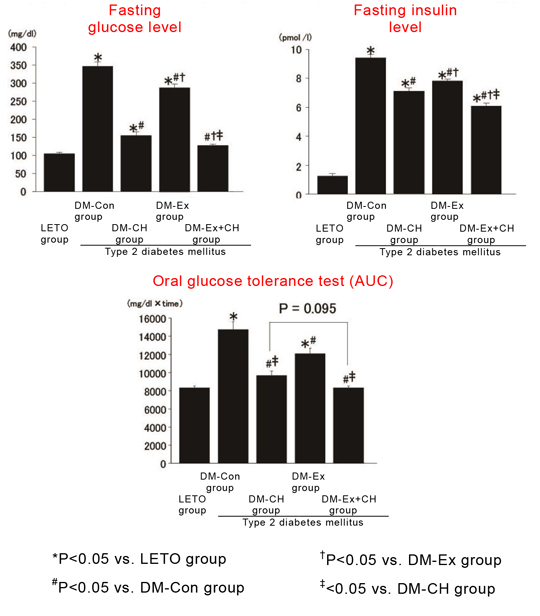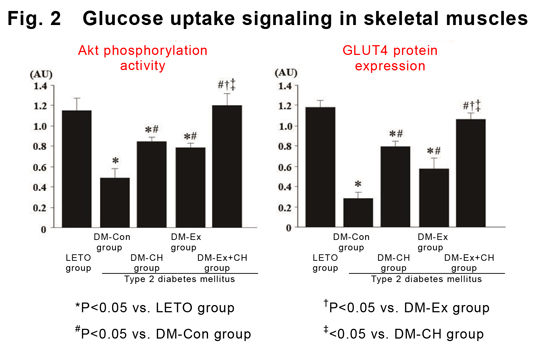- TOP
- List of reports
- Combination Effect of Chlorella Intake and Aerobic Training in Type 2 Diabetic Rats
Combination Effect of Chlorella Intake and Aerobic Training in Type 2 Diabetic Rats
【Scientific information】
Research and Development Department, Sun Chlorella Corporation
Combination Effect of Chlorella Intake and Aerobic Training in Type 2 Diabetic Rats
Presented at the 71st Annual Meeting of Japan Society of Nutrition and Food Science
- Study objectives
- In type 2 diabetes mellitus, aerobic training or long-term chlorella intake is thought to improve insulin sensitivity by promoting glucose uptake in skeletal muscles. However, it is unknown whether the combination of aerobic training and chlorella intake more effectively improve insulin sensitivity than each alone. We examined whether the combination of chlorella intake and aerobic training could effectively improve insulin sensitivity and glucose uptake in skeletal muscles than each alone in model animals with type 2 diabetes mellitus.
- Study method
- OLETF male rats (type 2 diabetic model rat) aged 20 weeks were divided into 5 groups,
7 rats in each group as follows, and the test was conducted.
OLETF rats were allocated in 4 groups from [2] to [5]. LETO rats were used as a
healthy control group.
[1] Healthy resting control group (LETO group)
[2] Resting control group (DM-Con group)
[3] Chlorella intake group (DM-CH group)
[4] Aerobic training group (DM-Ex group)
[5] Combination group of chlorella intake and aerobic training (DM-Ex+CH group)
DM-CH and DM-Ex+CH groups were given free access to basic feed containing 0.5% chlorella powder. DM-Ex and DM-Ex+CH groups ran on a treadmill at 25 m/min for 60 minutes 5 days a week for 8 weeks. After 8 weeks, at the end of exercise intervention, fasting glucose level and fasting insulin level were measured, and the oral glucose tolerance test*1 was conducted in all groups. After 48 hours, gastrocnemius muscle was extracted from the animals and Akt phosphorylation activity*2 and GLUT4 protein expression*3 were measured.
- Results
- Fasting glucose level and fasting insulin level significantly decreased (P<0.05) in
DM-CH and DM-Ex groups as compared with those in DM-Con group. They decreased
more in DM-Ex+CH group than each alone-group (P<0.05). Blood glucose area under
the curve (AUC) through the oral glucose tolerance test significantly decreased
(P<0.05) in DM-CH and DM-Ex groups as compared with that in DM-Con group. Also,
AUC significantly decreased (P<0.05) in DM-Ex+CH group as compared with DM-CH
group, and it showed the tendency of decrease as compared with that in DM-Ex group
(P=0.095). (Fig. 1)
Akt phosphorylation activity and GLUT4 protein expression in skeletal muscles significantly increased (P<0.05) in DM-CH and DM-Ex groups as compared with those in DM-Con group, and DM-Ex+CH group showed more significant increase than each alone-group (P<0.05). (Fig. 2)
The above results suggested that the combination of chlorella intake and aerobic training could more effectively improve insulin sensitivity in type 2 diabetic rats by increasing glucose uptake in skeletal muscles than each alone.Fig.1 Fasting glucose level, blood insulin, oral glucose tolerance test


Terminology
- *1: Oral glucose tolerance test
- After the exercise intervention, glucose was administered by oral route at 2 g per 1 kg of body weight after fasting for 12 hours, and glucose levels were measured before administration, 30 minutes after administration, and 60 minutes after administration. The area under the graph was calculated using blood glucose AUC.
- *2: Akt phosphorylation activity
- It is thought to be an insulin signaling pathway. It may promote glucose uptake through intracellular insulin signaling to GLUT4 protein that transports glucose in the blood into the cells of skeletal muscles.
- *3: GLUT4 protein expression
- It normally exists inside the cells. It seems to move to cell membrane by Akt phosphorylation activity and work as a glucose uptake pathway into the cells.
Details
- Academic society:
- The 71st Annual Meeting of Japan Society of Nutrition and Food Science
- Title:
- Combination Effect of Chlorella Intake and Aerobic Training in Type 2 Diabetic Rats
- Authors:
- Naoki Horii1), Natsuki Hasegawa1), Shumpei Fujie1), 2),Masataka Uchida1), Toru Mizoguchi3), Masato Onishi3), Motoyuki Iemitsu1)
- Affiliation:
- 1) Ritsumeikan University
2) Research Fellowship for Young Scientists (DC) of Japan Society for the Promotion of Science
3) Sun Chlorella Corporation





